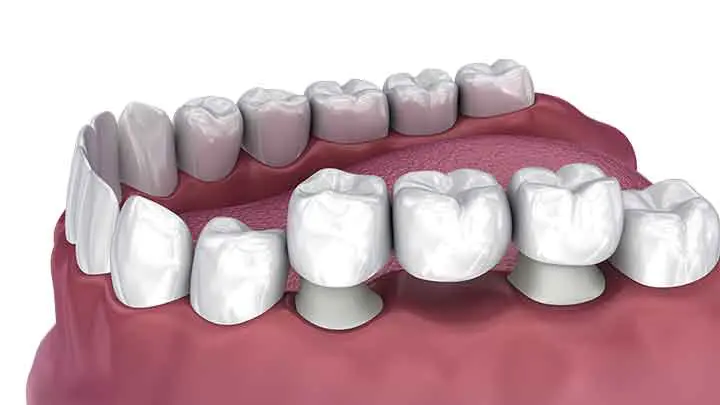Our Sumter, SC dental practice is dedicated to offering excellent dental bridge solutions. Because missing teeth can affect oral health and self-esteem, we use cutting-edge technology and materials to make long-lasting, natural-looking dental bridges. Each patient receives personalized care from our highly trained dental experts. Our practice strives to improve patients’ smiles and quality of life.
At Palmetto Family and Cosmetic Dentistry, we keep things simple and professional when it comes to choosing the right dental bridge for you. Whether it’s a classic bridge, cantilever, Maryland, or implant-supported bridge, we’ve got you covered. Our goal? To give you a bridge that not only functions like a champ but also blends in seamlessly with your natural teeth.
As a trusted provider of dental bridges in Sumter, SC, we’re all about excellence and making our patients happy. So if you’re ready to upgrade your smile and get back to feeling like your best self, we’re here to make it happen. Let’s get you smiling with confidence again!
Understanding Dental Bridges: Your Pathway to a Fuller Smile
Dental bridges are custom-made restorations used to fill gaps left by lost teeth. On either side of the bridge, natural teeth or implants support the artificial teeth. With a big smile, you can chew and speak better and look better. Bridges can be made of porcelain, ceramics, or metal alloys to look and feel like genuine teeth.
Knowing the varieties of dental bridges and picking one that suits you is vital. Most classic bridges include crowns on both sides and a pontic (artificial tooth) in between. For neighboring teeth, utilize cantilever bridges on one side of the missing tooth.
Maryland bridges are ideal for replacing front teeth because they use metal or porcelain bands to attach the artificial tooth to the rear of surrounding teeth. Implanted jawbone-anchored bridges give improved support and stability. Consult your dentist for the most significant oral health and smile options.
Types of Dental Bridges: Finding Your Perfect Match
Dental bridges are a popular solution for replacing missing teeth and improving your smile’s function and appearance. There are several types of dental bridges, each with its advantages, and the right choice often depends on the missing tooth or teeth’ location, oral health, and personal preferences. Here are the most common types of dental bridges:
Traditional Dental Bridges
Traditional bridges are the most common type. Dental crowns on the teeth next to the missing tooth hold one or more pontics (artificial teeth). They require healthy, strong teeth on either side of the missing tooth or teeth, as these teeth will need to be prepared (shaped and reduced in size) to support the bridge.
Cantilever Bridges
Like traditional bridges, cantilever bridges are utilized when neighboring teeth are on only one side of missing teeth. This type involves anchoring the pontic to a crown cemented to only one abutment tooth. While they can be a solution in certain situations, cantilever bridges are not recommended for areas of the mouth under stress, such as the back teeth.
Maryland Bridges
Maryland bridges (resin-bonded bridges) are considered a more conservative alternative to traditional bridges. Maryland bridges employ abutment tooth caps instead of crowns metal or porcelain framework bonded onto the back of the adjacent teeth. This method requires minimal removal of tooth enamel but may need to be stronger than traditional bridges.
Implant-Supported Bridges
Bridges supported by implants are the most solid and durable tooth replacement option. Without crowns or supports, these bridges anchored to dental implants. Typically, one implant is placed for every missing tooth, holding the bridge in place. Implant-supported bridges feel more like natural teeth and do not require support from adjacent teeth.
Choosing the Right Type
The choice of the right dental bridge depends on several factors:
- Number and location of missing teeth: Certain bridges are better suited for specific mouth areas.
- Condition of adjacent teeth: The health and stability of the surrounding teeth can dictate which bridge type will work best.
- Jawbone density: Sufficient bone density is crucial for implant success for implant-supported bridges.
- Budget and insurance coverage: The cost of different bridge types can vary significantly, as can insurance coverage.
- Personal preferences: Aesthetics, longevity, and the procedure’s invasiveness also influence your decision.
Feel free to consult us to determine which type of dental bridge is the most appropriate for your situation. We can assess your oral health and preferences to recommend the best solution.
The Functional and Cosmetic Advantages of Dental Bridges
Dental bridges offer a range of functional and cosmetic advantages that make them a popular choice for individuals looking to restore their smiles after tooth loss. These benefits improve oral health and enhance overall well-being and confidence. Here’s a closer look at the functional and cosmetic advantages of dental bridges:
Functional Advantages
- Restored Chewing Ability: Dental bridges restore the ability to chew properly by replacing missing teeth, allowing for a more varied and nutritious diet.
- Improved Speech: Missing teeth can affect speech by causing lisps or other speech impediments. Dental bridges help restore everyday speech by replacing the missing teeth essential for proper pronunciation.
- Prevention of Teeth Shifting: When a tooth is missing, the surrounding teeth can shift into a space, leading to misalignment. A dental bridge fills the gap, preventing the surrounding teeth from moving and maintaining a proper bite and alignment.
- Even Distribution of Bite Force: By replacing missing teeth, bridges help distribute the forces in your bite more evenly, which can prevent wear and tear on the natural teeth and protect against TMJ (temporomandibular joint) disorders.
Cosmetic Advantages
- Restored Smile: A dental bridge fills in the gaps caused by missing teeth, significantly improving the appearance of your smile. This can boost self-esteem and confidence.
- Maintained Facial Shape: Tooth loss can lead to the loss of support for the facial structure, resulting in a sunken appearance. Dental bridges support the facial tissues for a more youthful and natural appearance.
- Improved Aesthetics of Your Teeth: Besides just filling gaps, bridges are customized to fit your teeth’s color, shape, and size, improving the overall look of your smile. Modern materials used in bridges (like porcelain) can mimic the clarity and gloss of natural teeth, making the repair look like real teeth.
- Immediate Results: Compared to other dental restoration options that may require several months to complete (like dental implants), dental bridges can provide a quicker solution to enhance your smile.
Dental bridges can improve the quality of life for those losing teeth by improving function and appearance. Bridges restore eating and speaking skills, prevent teeth from shifting, and improve smiles. The health of surrounding teeth, the tooth gap, and personal preferences determine whether a dental bridge suits a person. We’ll help you choose the best dental restoration therapy and ensure its life and success.
Best Practices for Dental Hygiene with Bridges
Maintaining good oral hygiene is crucial for the longevity and success of dental bridges. Proper care not only extends the bridge’s life but also helps prevent gum disease and decay in the remaining natural teeth. Here are the best practices for dental hygiene with bridges:
Regular Brushing and Flossing
- Brushing: Use fluoride toothpaste and a soft-bristle toothbrush twice a day. Be sure to brush around and under the dental bridge and the crowns that anchor it.
- Flossing: Use a floss threader or particular types of floss (such as super floss) designed to clean around and under the bridge and between the natural teeth. It removes plaque and food particles a toothbrush might not reach.
Use an Antiseptic Mouthwash
Antibacterial mouthwash kills bacteria and reduces plaque around the dental bridge and the rest of your teeth. It’s an excellent addition to your daily oral hygiene routine.
Clean Under the Bridge
Special cleaning aids like interdental brushes or water flossers can effectively clean difficult-to-reach areas under and around the bridge. These tools can help remove food particles and plaque that accumulate under the pontic (the false tooth part of the bridge).
Avoid Hard and Sticky Foods
Hard and sticky foods can damage your bridge or cause it to become loose. Avoid chewing hard foods (like ice or hard candy) and gummy candies that can pull on the bridge.
Regular Dental Checkups
Regularly see your dentist for cleanings and exams. Your dentist can examine your teeth bridge and ensure that your gums and surrounding teeth remain healthy. Professional cleanings eliminate tartar and plaque regular brushing and flossing might miss.
Avoid Tobacco and Limit Staining Foods and Drinks
Tobacco products can stain your bridge and natural teeth and increase gum disease risk can undermine the support for your bridge. Similarly, limiting the consumption of staining substances like coffee, tea, and red wine can help keep your bridge looking its best.
Be Mindful of Clenching and Grinding
If you clench or grind your teeth, you may put extra pressure on your bridge, potentially damaging it. Talk to your dentist about getting a mouth guard to protect your teeth and bridge while you sleep.
Good oral hygiene protects your dental bridge and your oral health. To maintain your bridge and surrounding teeth, brush, and floss regularly, use the correct cleaning products, prevent bad habits, and visit the dentist. To prolong the life of your dental bridge, follow your dentist’s care instructions.
Ready to Restore Your Smile?
At Palmetto Family and Cosmetic Dentistry, we’re committed to helping you confidently restore your smile. Our expert team specializes in dental bridge solutions tailored to your needs. With cutting-edge technology and a compassionate approach, we ensure your experience is comfortable and results-oriented.
Whether you’re looking to replace missing teeth or enhance your smile’s aesthetics, we’re here to guide you every step of the way. Contact us today to learn how we can transform your dental health and help you smile with renewed confidence. Your journey to a perfect smile begins with us.

